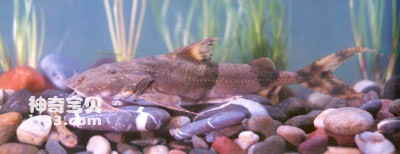The bagarius (Bagarius bagarius) belongs to the order Bagarius and the genus Bagarius in the family Bagarius. Commonly known as: melon fish, yellow croaker. English name: Yellow sisorid-catfish.
Endangerment level: Vulnerable.
The head and front part of the body are particularly thick and flat. The dorsal edge is the highest on the body at the starting point of the dorsal fin, gradually lowering toward the front and back. The caudal peduncle is rounded and the ventral surface is flat. The head is broad and the front end is wedge-shaped. The muzzle is blunt and round. The mouth is large, lower, and curved; the tooth tips are tapered and vary in size. The mandibular teeth are sparser than the premaxillary teeth, and the outer row teeth are larger and arranged in about one row. The eyes are small and located on the dorsal side of the head. It has 1 pair of jaw barbels and 3 pairs of chin barbels. The jaw barbels are well developed, wide and flat, with a slender end, extending to the rear end of the base of the pectoral fin. The chin barbels are connected to the snout by skin folds; the chin barbels are slender. The skin on the back of the head and body surface is rough and covered with longitudinal ridges, and the ventral surface is smooth. The rear edge of the dorsal fin spines is smooth, with a soft end, extending into a filamentous shape; the adipose fin is short; the pectoral fin is flat, with weak serrations on the rear edge of the spines, and the end is also filamentous, extending to the posterior end of the pelvic fin base; the caudal fin is large, deeply bifurcated, up and down The ends of the leaves are extended into filaments. The body is grayish-yellow, with a large gray-black saddle-shaped spot behind the dorsal fin, below the adipose fin, and in front and above the base of the caudal fin, extending downward across the lateral line. There are black spots on the even fins and caudal fin.
It mainly inhabits the main channels of large rivers and is a bottom-dwelling fish. It is ferocious and predatory and feeds mainly on small fish, but also frogs and shrimps. Breeds around May-June.
Domestically distributed in the lower reaches of the Lancang River; abroad distributed in India, Myanmar and Thailand.
Little is known about its wild state. But it is often seen. In recent decades, due to the rapid increase in population in the production areas, the use of harmful fishing methods such as electricity, poison, and explosion has become more common, resulting in a sharp decrease in the amount of its resources.

animal tags:
We created this article in conjunction with AI technology, then made sure it was fact-checked and edited by a Animals Top editor.